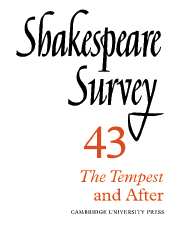Book contents
- Frontmatter
- The Power of Magic: From Endimion to The Tempest
- Reading The Tempest
- The Latter End of Prospero’s Commonwealth
- Henry VIII and the Deconstruction of History
- The Politics of Conscience in All is True (or Henry VIII)
- Shakespeare’s Romantic Innocents and the Misappropriation of the Romance Past: The Case of The Two Noble Kinsmen
- The Hand of John Fletcher in Double Falsehood
- ‘The Duke my Father’s Wrack’: The Innocence of the Restoration Tempest
- ‘Remember/First to Possess his Books’: The Appropriation of The Tempest 1700-1800
- The Tempest and After
- Poetry’s Sea-Changes: T. S. Eliot and The Tempest
- The New Function of Language in Shakespeare’s Pericles: Oath versus ‘Holy Word’
- The Discovery of The Rose Theatre: Some Implications
- The Origins of the Roxana and Messallina Illustrations
- Recycling the Early Histories: ‘The Wars of the Roses’ and ‘The Plantagenets’
- Shakespeare Production in England in 1989
- Professional Shakespeare Productions in the British Isles, January-December 1988
- The Year's Contributions to Shakespeare Studies: 1 Critical Studies
- 2 Shakespeare’s Life, Times, and Stage
- 3 Editions and Textual Studies
- Books Received
- Index
The Tempest and After
Published online by Cambridge University Press: 28 March 2007
- Frontmatter
- The Power of Magic: From Endimion to The Tempest
- Reading The Tempest
- The Latter End of Prospero’s Commonwealth
- Henry VIII and the Deconstruction of History
- The Politics of Conscience in All is True (or Henry VIII)
- Shakespeare’s Romantic Innocents and the Misappropriation of the Romance Past: The Case of The Two Noble Kinsmen
- The Hand of John Fletcher in Double Falsehood
- ‘The Duke my Father’s Wrack’: The Innocence of the Restoration Tempest
- ‘Remember/First to Possess his Books’: The Appropriation of The Tempest 1700-1800
- The Tempest and After
- Poetry’s Sea-Changes: T. S. Eliot and The Tempest
- The New Function of Language in Shakespeare’s Pericles: Oath versus ‘Holy Word’
- The Discovery of The Rose Theatre: Some Implications
- The Origins of the Roxana and Messallina Illustrations
- Recycling the Early Histories: ‘The Wars of the Roses’ and ‘The Plantagenets’
- Shakespeare Production in England in 1989
- Professional Shakespeare Productions in the British Isles, January-December 1988
- The Year's Contributions to Shakespeare Studies: 1 Critical Studies
- 2 Shakespeare’s Life, Times, and Stage
- 3 Editions and Textual Studies
- Books Received
- Index
Summary
As a child, did you never hold a shell to your ear and listen ... hear the surge of your heart's blood, the murmur of the thoughts in your brain, the snapping of a thousand little worn-out fibres in the tissues of your body?
This essay addresses itself to some works by three Scandinavians who in various ways wrote 'after The Tempest'. It also examines that play's tendency to turn, in the hands of writers and critics, into a seashell. What you hear when you hold a shell to your ear are processes of life within yourself - as, in the lines quoted above, Indra's daughter explains to the Poet in the Fingal's Cave scene of Strindberg's A Dreamplay. The neurobiological details of her image may be somewhat dubious, but the bearing of the image itself is clear. In its context it becomes particularly self-reflexive, for in the cave, which is shaped both like a shell and an ear, the god listens to humans and humans listen to winds and waves, trying to find a language to define 'reality', 'poetry', 'dreams'.
It so happens that A Dreamplay is one of many works, from many cultures and languages, in which The Tempest is present, not necessarily as a verbally identifiable 'source' or 'influence' but as a shell which the writer has held to his or her ear. That peculiar quality of The Tempest which Anne Barton identifies, in her Introduction to the New Penguin edition of the play, as 'secretive', depending 'upon the suppressed and the unspoken', this quality also, as she puts it, 'compels a peculiarly creative response'.
- Type
- Chapter
- Information
- Shakespeare Survey , pp. 109 - 120Publisher: Cambridge University PressPrint publication year: 1991

